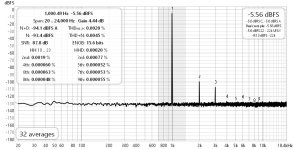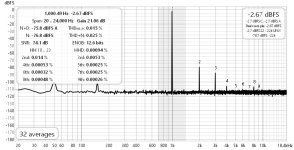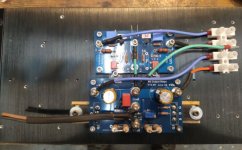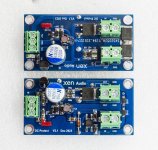The Spice file for the OPS has been published before :
https://www.diyaudio.com/community/...-and-maybe-a-power-whammy.390636/post-7309540
There is no accurate model for the Toshiba TO220 MOSFETs.
So here is one for the 2N5457/60 -- FQP3N30/3P20 version.
But this is work in progress, as only the frontend has been built and tested.
And as always, it is only as accurate as the device models.
Maybe you have better ones for the Fairchild JFETs ?
Thank you for your interest,
Patrick
https://www.diyaudio.com/community/...-and-maybe-a-power-whammy.390636/post-7309540
There is no accurate model for the Toshiba TO220 MOSFETs.
So here is one for the 2N5457/60 -- FQP3N30/3P20 version.
But this is work in progress, as only the frontend has been built and tested.
And as always, it is only as accurate as the device models.
Maybe you have better ones for the Fairchild JFETs ?
Thank you for your interest,
Patrick
Attachments
Last edited:
Next one to follow is the F5Pi frontend using 2N5457/5460 + FQP3N30/3P20.
As expected, distortion is quite a bit higher at -77dB H2 and -86dB H3 for 2.8Vrms 1kHz output.
Still comparable to the latest F5m, despite the very low transconductance input JFETs :
https://www.diyaudio.com/community/threads/pass-f5m.406472/post-7534522
The Spice simulation is actually quite accurate on H2 at least.
Patrick
.
As expected, distortion is quite a bit higher at -77dB H2 and -86dB H3 for 2.8Vrms 1kHz output.
Still comparable to the latest F5m, despite the very low transconductance input JFETs :
https://www.diyaudio.com/community/threads/pass-f5m.406472/post-7534522
The Spice simulation is actually quite accurate on H2 at least.
Patrick
.
Attachments
Short update :
Beta Testers have got their PCBs made, and ordered From Mouser / DK.
One tester already have all transistors.
The other has his waiting to clear Customs.
So with some luck, we should hear from them before long.
Then we'll publish frontend and OPS Gerber.
The team in Hong Kong has sorted out our inventory.
We can support 20 Toshiba Q sets with our usual curve traced matching.
We probably have 20 additional sets of Fairchild devices already in the EU.
So there will be enough for all, I think.
Of course you can source your own elsewhere.
Enough offers around.
Merry Christmas to all,
Patrick
Beta Testers have got their PCBs made, and ordered From Mouser / DK.
One tester already have all transistors.
The other has his waiting to clear Customs.
So with some luck, we should hear from them before long.
Then we'll publish frontend and OPS Gerber.
The team in Hong Kong has sorted out our inventory.
We can support 20 Toshiba Q sets with our usual curve traced matching.
We probably have 20 additional sets of Fairchild devices already in the EU.
So there will be enough for all, I think.
Of course you can source your own elsewhere.
Enough offers around.
Merry Christmas to all,
Patrick
Hi all,
A few posts back I mentioned that I wold send the F5Pi to another tester to get impressions from someone who is not involved in the build, and leave it with him for a a while to get the subjective opinions of someone else. The tester here has had lots of amps, both commercial and DIY, and has had good hifi systems for many years. The idea here is not to "sell" the idea, but I know all of us want to know if something sounds good before we build it. Its very hard to know that unless you've heard the DUT - so I thought if I got one or two others to listen to this amp, and posted their impressions, then it might at least give some idea of what others think of it.
Fran
A few posts back I mentioned that I wold send the F5Pi to another tester to get impressions from someone who is not involved in the build, and leave it with him for a a while to get the subjective opinions of someone else. The tester here has had lots of amps, both commercial and DIY, and has had good hifi systems for many years. The idea here is not to "sell" the idea, but I know all of us want to know if something sounds good before we build it. Its very hard to know that unless you've heard the DUT - so I thought if I got one or two others to listen to this amp, and posted their impressions, then it might at least give some idea of what others think of it.
Fran
Having been asked to jot a few lines regarding the amp I’ve adopted as “ The Phantom” and having little experience doing this, I’m finding it difficult, as my benchmark amplifiers are, I’m sure quite different to yours, but I did agree to give it a go.
My system consists, mostly, of;
Ruark Accolade Speakers (long in the tooth, but wonderful on the ears),
Amplifiers: LM3875 amp with jfet buffer and running from a beefy LiFePO4 battery supply, Airtight ATM4 (6L6 amp in PP)
Philips 73 CD Player (with improved output stage),
DIY SD player + Miro AD1862 Dac with 6N2 & FC CEN IV output stages,
Pink Triangle LPT, Roksan Artimiz Tone Arm, Clearaudio Discovery Cart, Tom Evans Micro Groove Plus phono stage.
Various cables.
Amps I’ve had my system over the years include; Sony ES (several), Naim Nait MK1, Jadis, Croft, Gamut, Classe, countless DIY amps on loan, you guys get the idea.
First, this is a very neat integrated with a superior build quality to just about anything I’ve had in my system, it’s a gem of a build, with the given title of “F5Pi”. I reckon “The Phantom” is better.
OK, this little unit; 32 x 34.5 x 14.5 cm (ish), is the best amp that’s been in my system, it gives more, and I mean of everything and all with an output of little more than 20 watts per channel.
More Bass, Separation, Detail, Soundstage, Dynamics, Clarity, Presence, Attack, the list just keeps going.
The big ticket here is Detail, masses, of detail.
The ability to stop and start in a nano-second, is a thing I only previously experienced from high priced amps. This little unit is scary in how well it can follow music, instrument separation is clean and positional, allowing you to follow music passages or individual instruments easily, even if part of a complex piece or a live recording.
It’s introduced me to instruments I hadn’t before realised were in a recording, given me the insight to distinguish between types of guitar, or whether it’s a clavichord or harpsichord or upright piano or indeed a dulcimer. I found myself following kick drum patterns, they were produced tight, clean and deep with each beat identifiable. Cymbals have impact and sustain, ride cymbals shimmer, Hi-Hats sizzle and click, snare drums have a snap and crack to them, rim shots can’t be mistaken for anything other than a rim shot. When a drummer plays around the kit you can follow his movement.
Bass is strong and tight, lower than either of my current amps and produces more than I thought my Accolades could handle. I first heard this amp paired with Quad 63s, they produced bass they were never designed to produce, impressive.
Soundstage, to my mind, is very speaker/room dependent, in my room this relates more front to back without getting toooo wide. The lead instrument, notably singers are pushed to the fore, just enough to separate off of the main body. Vocals are syllable accurate, as a music fan and avid listener, this is a big plus, partially due to the fact I use hearing aids, so clarity helps with my listening pleasure.
The F5Pi amp loves the Accolades, it’s a match one can only dream about, the synergy they have works incredibly well. I’ve only had theF5Pi, Phantom for a week and in that time I’ve put a lot of hours on it, and even in this short time it’s improving, a fraction more body/heft coming through. I think it’ll be into the New Year before it reaches its full potential.
I swapped over the output stages on my DAC several times and the amp allows the differences to come through. What a great thing to have in your arsenal. Female vocal the 6N2, Alt Country the FC Sen, overall I think the FC Sen is a tad better match with the F5Pi, but rich vocals are in the realm of the 6n2. Not a whole lot in it but identifiable, depending on what you fancy on the day or the type of music played.
I seldom use my CDP to sit and listen, I use it to quickly get a feel for any CD I buy and the odd time let it perfume the air at a low volume, it has, in general a flat, slightly muddy, presentation with an edgy overtone. Now hooking it up to the F5Pi, has given this cheap player a new lease of life, it has detail, separation, a nice balance and clarity. This caught me by surprise, a nice surprise, but not at all what I was expecting. Since then I’ve happily dropped CDs into the tray and enjoyed the result, another plus point for the Phantom.
Nothing I played through the amp was unlistenable, but be warned it shows recordings for what they are. I’m quite loathe to have to return this lovely wee amp.
This Japanese DIYer compared a lot of different devices for his circuit.
http://myaudio.seesaa.net/article/399698446.html#toc_06
His conclusions on the K3497/J618 are quite similar to our reviewer above.
You need to give it time to run in.
And maybe you also need to get used to the sudden increase in details.
You can find common impressions on details with amps using these so-called UHC MOSFET's from Japanese manufacturers a few years back.
Including designs by Akihito Kaneda.
Here another one on UHC-MOS :
http://la4.cocolog-nifty.com/blog/2011/02/uhc-mos-fet-93c.html
Patrick
http://myaudio.seesaa.net/article/399698446.html#toc_06
His conclusions on the K3497/J618 are quite similar to our reviewer above.
You need to give it time to run in.
And maybe you also need to get used to the sudden increase in details.
You can find common impressions on details with amps using these so-called UHC MOSFET's from Japanese manufacturers a few years back.
Including designs by Akihito Kaneda.
Here another one on UHC-MOS :
http://la4.cocolog-nifty.com/blog/2011/02/uhc-mos-fet-93c.html
Patrick
Last edited:
Oh, one more OT point if I may :
Looking at the above picture, the totally encapsulated toroidal transformer is maybe 150~160mm diameter.
It is claimed to be 1000VA. And I searched Toroidy for similar size.
Toroidy Supreme 100VA is 210x90mm, 500VA is 168x80mm.
So either they are using a toroidy with double the height (~160mm), or with much higher pearmeability material.
And then it says in the photo "handcrafted in Germany".
I wonder if that means that they don't use a winding machine, but thread each turn through the toroid with a bobbin.
How many hours would you need to make one of these by hand ?
And we already knew how much heat their heatsinks can dissipate.

Patrick
Looking at the above picture, the totally encapsulated toroidal transformer is maybe 150~160mm diameter.
It is claimed to be 1000VA. And I searched Toroidy for similar size.
Toroidy Supreme 100VA is 210x90mm, 500VA is 168x80mm.
So either they are using a toroidy with double the height (~160mm), or with much higher pearmeability material.
And then it says in the photo "handcrafted in Germany".
I wonder if that means that they don't use a winding machine, but thread each turn through the toroid with a bobbin.
How many hours would you need to make one of these by hand ?
And we already knew how much heat their heatsinks can dissipate.
Patrick
😱
There’s number of parts, but also density of parts!
That being said, it looks fascinating.
Nobody can stop you using an oversized case with plenty of space.
Larger heatsinks won't harm either.
Although some believe that they sound better when they are really warm.
I am criticizing your work at all, I hope you know that.
I still think such a project would be an epic journey for me. Maybe I would not make it all the way to Mount Doom.
I am just fascinated by the fact amplifying can be achieved with a myriad of arrangements, with very few parts or a great many parts.
For the new year a further improved version of the speaker protection circuit of post #46.
https://www.diyaudio.com/community/...tage-perfectly-integrated.406024/post-7532667
Works first time.
The US version of the F5Pi above has a bit of DC drift from cold to warm (~100mV).
This is caused by the JFET pair 2N5457/5460.
So a DC servo daughter board has been designed and will be tested later as add-on.
Optional, without saying.
Patrick
.
https://www.diyaudio.com/community/...tage-perfectly-integrated.406024/post-7532667
Works first time.
The US version of the F5Pi above has a bit of DC drift from cold to warm (~100mV).
This is caused by the JFET pair 2N5457/5460.
So a DC servo daughter board has been designed and will be tested later as add-on.
Optional, without saying.
Patrick
.
Attachments
- Home
- Amplifiers
- Pass Labs
- The F5Pi -- F5P Voltage Gain Stage + M2 Output Stage = Perfectly Integrated





